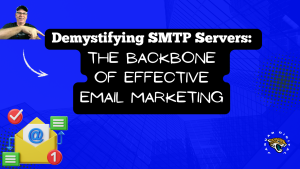In the vast realm of digital marketing, few tools wield as much power and influence as email marketing. Despite the rise of various social media platforms and messaging apps, email remains a cornerstone of communication, particularly in the business world. However, behind every successful email marketing campaign lies a crucial yet often overlooked component: the SMTP server.
SMTP, or Simple Mail Transfer Protocol, serves as the backbone of email communication, facilitating the transmission of messages from sender to recipient. In the context of email marketing, SMTP servers play a pivotal role in ensuring that marketing emails reach their intended audience efficiently and reliably. In this comprehensive guide, we’ll delve into the intricacies of SMTP servers, their significance in email marketing, and how businesses can leverage them to enhance their marketing efforts.
1 - Understanding SMTP Servers
At its core, an SMTP server is a specialized computer program or software application responsible for sending, receiving, and relaying email messages across networks. When you hit “send” on an email, your email client communicates with an SMTP server to initiate the delivery process. The SMTP server then processes the message, routing it to the appropriate destination based on the recipient’s email address.
SMTP servers operate on a client-server model, where the client (your email client or application) communicates with the server to send outgoing messages. These servers utilize various protocols and encryption mechanisms to ensure secure and efficient transmission of emails over the internet.

2 - The Role of SMTP Servers in Email Marketing
In the realm of email marketing, SMTP servers are indispensable tools for businesses looking to engage with their target audience effectively. Here’s how SMTP servers contribute to the success of email marketing campaigns:
Reliable Delivery: SMTP servers are optimized to handle large volumes of outgoing emails, ensuring that marketing campaigns reach recipients without delays or interruptions. By leveraging robust SMTP infrastructure, businesses can enhance the deliverability of their marketing messages and minimize the risk of emails ending up in spam folders.
Authentication and Security: SMTP servers employ authentication mechanisms such as SPF (Sender Policy Framework) and DKIM (DomainKeys Identified Mail) to verify the identity of senders and prevent spoofing or unauthorized access. This enhances the credibility of marketing emails and reduces the likelihood of them being flagged as spam by recipient servers.
Tracking and Analytics: Many SMTP servers offer built-in tracking and analytics features that enable marketers to monitor the performance of their email campaigns in real-time. From open rates and click-through rates to bounce rates and conversion metrics, these insights empower businesses to refine their strategies and optimize future campaigns for better results.
Customization and Personalization: With SMTP servers, marketers can personalize their email campaigns by dynamically inserting recipient names, customized content, and targeted offers based on user preferences and behavior. This level of customization enhances engagement and fosters stronger connections with subscribers, ultimately driving higher conversion rates.
Scalability and Flexibility: Whether you’re a small startup or a multinational corporation, SMTP servers offer scalability and flexibility to accommodate your evolving email marketing needs. From handling seasonal spikes in email volume to supporting automated drip campaigns and transactional emails, SMTP servers can adapt to the demands of your growing business.
3 - Choosing the Right SMTP Server
Selecting the right SMTP server is crucial for the success of your email marketing initiatives. Here are some factors to consider when evaluating SMTP provider
Reliability and Uptime: Look for SMTP providers with a track record of reliability and high uptime guarantees. Downtime can disrupt your email campaigns and impact your brand’s reputation, so choose a provider with robust infrastructure and redundant systems to minimize the risk of service interruptions.
Deliverability Rates: Investigate the deliverability rates of different SMTP providers to ensure that your marketing emails reach recipients’ inboxes consistently. Providers with strong deliverability metrics often employ advanced delivery optimization techniques and maintain positive relationships with internet service providers (ISPs) to avoid spam filtering.
Security Features: Prioritize SMTP providers that prioritize security and offer comprehensive measures to protect your email infrastructure from threats such as phishing attacks, malware, and unauthorized access. Encryption, authentication protocols, and proactive monitoring are essential components of a secure SMTP environment.
Integration Capabilities: Consider the integration capabilities of SMTP providers with your existing email marketing software, CRM (Customer Relationship Management) systems, and other third-party applications. Seamless integration streamlines your workflow and allows for seamless data exchange between different platforms.
Support and Customer Service: Evaluate the quality of customer support provided by SMTP providers, including availability, responsiveness, and expertise. In the event of technical issues or inquiries, prompt and knowledgeable support can make a significant difference in resolving issues and minimizing downtime.

4 - Best Practices for Email Marketing with SMTP Servers
Once you’ve chosen an SMTP server provider, it’s essential to implement best practices to maximize the effectiveness of your email marketing campaigns:
Maintain a Clean and Opt-in Email List: Regularly clean your email list to remove inactive or invalid addresses, and ensure that subscribers have explicitly opted in to receive communications from your brand. This improves deliverability and reduces the likelihood of your emails being marked as spam.
Segmentation and Targeting: Segment your email list based on demographics, preferences, purchase history, and engagement levels to deliver personalized content that resonates with different audience segments. Targeted campaigns are more effective in driving conversions and fostering customer loyalty.
Optimize for Mobile Devices: With an increasing number of users accessing emails on smartphones and tablets, it’s essential to optimize your email templates for mobile devices. Ensure that your emails are responsive, visually appealing, and easy to navigate on smaller screens to maximize engagement.
A/B Testing and Optimization: Experiment with different subject lines, email copy, calls-to-action, and design elements through A/B testing to identify what resonates best with your audience. Continuously analyze and optimize your campaigns based on performance metrics to achieve better results over time.
Monitor Deliverability and Engagement Metrics: Regularly monitor key metrics such as open rates, click-through rates, bounce rates, and unsubscribe rates to gauge the effectiveness of your email campaigns. Use this data to identify trends, patterns, and areas for improvement, and adjust your strategies accordingly.

Conclusion
In the realm of email marketing, SMTP servers serve as the linchpin that connects businesses with their target audience, enabling seamless communication and engagement. By understanding the role of SMTP servers, selecting the right provider, and implementing best practices, businesses can unlock the full potential of email marketing and drive meaningful results for their brands.
In an era of ever-evolving digital marketing landscapes, the importance of effective email communication cannot be overstated. With the right strategies and tools in place, businesses can leverage SMTP servers to forge stronger connections with their audience, nurture customer relationships, and achieve their marketing objectives with precision and efficiency.


